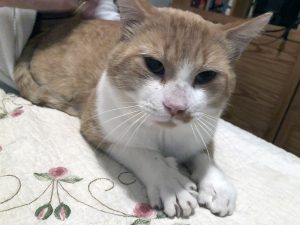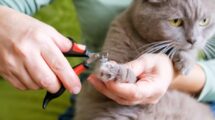Animal Chatter
By Iris Winston

I first noticed him in February when he and my cat started hanging out together. I didn’t know then that the little red-and-white tabby was homeless, though it was clear that he was scared of human contact. However slowly I approached him, he ran away, a flash of red fur as he disappeared into the distance.
I started putting food and water on the front step in case he was a stray. The food disappeared each night, and at least some of the time, I saw him eating. I also, apparently, attracted another visitor. On one occasion, late at night, I saw a very large raccoon sampling the buffet when I opened the front door.
He stared at me and held his ground. His message was clear: “I am going to eat all this food. Want to make something of it?”
I didn’t. Instead, I refilled the dish after he left and waited quietly until the little red cat (now temporarily named LC for lost or little cat) appeared. If you repeat LC quickly, it becomes Elsie, a fine name for a female feline. At the time, I wasn’t allowed close enough to determine his gender. I just saw a very small, attractively marked cat.
The food/cat sighting arrangement continued for a couple of months. I tried sitting very still on the porch, talking quietly when I saw him. Gradually, he tolerated my presence. I very much wanted to reach out to touch him but knew that if I moved, he would run, and the trust I was trying to build would be broken.
Quite often, when I was walking Marnie, my Irish Setter, Freya, my Norwegian Forest cat, would follow or meet us in the nearby park. A few times, the little red cat joined the parade at a safe distance. He felt comfortable, as long as there was plenty of space between us and Freya was in the middle.
By this time, it was mid-August, and I was beginning to think that this near-feral cat was unlikely to allow me any closer. But I kept up the routine of talking to him while he was eating and, by the end of the month, he allowed me to stroke him as he ate. I made no attempt to pick him up until a rainy day in September when he purred as I stroked him.
I brought him inside and took him to the quiet place that I had prepared for him: a spare bedroom, complete with food, water, a scratch pad, a clean litter box, a big window, and a couple of
hiding places. I closed the door and gave him time to adjust to his safe spot. Later in the evening, I visited him and repeated the routine of talking quietly and stroking him. He allowed the
attention, purred a little, and seemed ready to settle in for the night.
The next stage was a trip to the vet to have him scanned for microchip identification, followed by a health check and basic vaccinations. He was pronounced healthy but had no microchip.
(Now he does, complete with my contact information.) Next on the list was neutering so that whatever his future, it would include fewer fights, and he would not father any unwanted kittens.
When I collected him after his surgery, he immediately retreated to his safe place. Over the next few days, I left the door of his room open and gradually gave him access to the rest of the house.
Along the way, he and Marnie have learned to lie down alongside each other quietly — not close friends yet, but at least mutually respectful acquaintances. He and Freya have been fine together from the beginning. After all, she was the one who brought her new friend — now named Rufus (meaning the red-haired one) — home in the first place.
I doubt that Rufus will ever be as completely domesticated as Freya because of his eight months or more of seemingly being homeless. He is still anxious to go outside every morning but returns
for supper and is then happy to stay inside and snuggle on my lap, purring loudly. Moving is listed as one of the five most stressful experiences for human beings. It is just as stressful for animals. So, when adopting a pet, whether a stray such as Rufus or through a breeder or a humane or rescue society, setting up a quiet, safe place will make life much easier for the animal. It is also wise to go slowly in introducing the newcomer to any other pets in the household and to ensure that there is no competition for sleeping places or food. In those early stages, it is a good idea to avoid too many people or excitement.
A clean litter box (one per cat in the household, plus an extra one for good measure) is vital. Most cats and kittens naturally prefer their own bathrooms and do not require the housetraining routine that puppies do.
Animals — like children — are happiest with a well-established routine and definite boundaries, so make the rules clear and, most of all, ensure that you make plenty of time for showing all the animal residents, new and old, that they are loved and valued.
Almonte, Ontario writer, Iris Winston, is a former Executive Director of the Canadian Federation of Humane Societies. She has been an animal lover all her life. Her pets have always been important members of her family.






